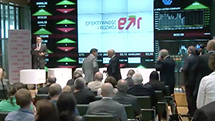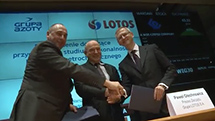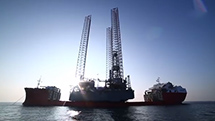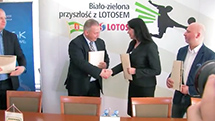32. Objectives and policies of financial risk management
The Group is exposed to financial risks, including:
- market risk (risk related to prices of raw materials and petroleum products, risk related to prices of CO2 allowances, currency risk, interest rate risk),
- liquidity risk,
- credit risk related to financial and trade transactions.
The Parent operates a Financial Risk Management Office, which coordinates and exercises ongoing supervision of the Group's financial risk management processes.
Furthermore, the Price Risk and Trading Committee, appointed by the Management Board, supervises the work on development of policies and procedures, and monitors implementation of the Group's strategy in the area of its responsibilities. Specifically, the Committee provides opinions on or initiates key price and trading risk management initiatives, makes recommendations, and submits proposals for actions that require the Management Board's approval.
In addition, to ensure effective management of liquidity, debt structure and external finance raising by companies of the LOTOS Group, the Management Board has appointed the Liquidity Optimisation and Financing Coordination Team.
Financial risk management seeks to achieve the following key objectives:
- increase the probability that budget and strategic objectives are met,
- limit volatility of cash flows,
- ensure short-term financial liquidity,,
- maximise the result on market risk management within the assumed risk level limits,
- create value in the long-term.
With a view to implementing the above objectives, the Group has put in place relevant tools and developed a number of documents, which were then approved at the relevant decision-making levels and which define the framework for ensuring effectiveness and safety of the Company's financial activities, including:
- methodology for quantifying exposures to particular risks,
- acceptable financial instruments,
- methodology of assessing financial risk management,
- risk management limits,
- the reporting method,
- credit limits,
- documentation and operating standards,
- division of responsibilities in transaction execution, risk assessment and monitoring, and transaction recording and settlement between different organisational units.
The Parent monitors and reports all managed market risks on an ongoing basis. Grupa LOTOS S.A. uses liquid derivatives which can be measured by applying commonly used valuation models. The valuation of the underlying position and derivatives is based on market inputs provided by reliable sources. Opening positions with respect to risks which do not arise as part of the Company’s core business is prohibited.
On January 1st 2011, the Parent commenced hedge accounting with respect to cash flows (i.e. foreign-currency facilities used to finance the 10+ Programme, designated as hedges of future USD-denominated petroleum product sale transactions). In H2 2012, the scope of cash flow hedge accounting was extended to include newly established hedging relationships of the same nature.
32.1 Risk related to prices of raw materials and petroleum products
The Group considers risk related to prices of raw materials and petroleum products to be particularly important.
The Company identifies the following factors of this risk:
- volatility of the refining margin, measured as the difference between the liquid index of a reference petroleum product basket (e.g. aviation fuel, gasoline, diesel oil, fuel oil) and the liquid index of reference feedstock (e.g. Urals crude),
- volatility of prices with respect to the raw material and product inventory volumes deviating from the required levels of mandatory and operational stocks,
- volatility of differentials between the reference indices and indices used in commercial contracts (e.g. Urals-Brent differential, i.e. the difference between different types of crude oil),
- use of non-standard pricing formulae in commercial contracts.
In order to secure fixed petroleum product prices for future deliveries to customers, the Group has implemented a system whereby the risk can be transferred from the customers onto the Group. This requires execution of appropriate price risk hedging transactions and implementation of procedures providing protection against credit and operational risks.
As part of the measures discussed above, in 2012 and 2013, in connection with sales of bitumen components the Group entered into commodity swap contracts, which helped it maintain its original price risk profile. The swap contracts concluded in that period were partially settled in the year when they were entered into, and partly in the following year.
Open commodity swaps as at December 31st 2013:
| Type of contract | Reference index |
Contract execution period |
Valuation period |
Amount in tonnes in the valuation period |
Average weighted price (USD/t) |
Fair value (PLN ‘000) | |
|---|---|---|---|---|---|---|---|
| Financial assets | Financial liabilities | ||||||
| Commodity swap | 3.5 PCT Barges FOB Rotterdam | Sep–Nov 2013 | Mar–Oct 2014 | 20,989 | 572.90 | 736 | - |
| Total | 736 | - | |||||
The above swap transactions for the total amount of 20,989 tonnes based on the 3.5 PCT Barges FOB Rotterdam liquid index during the period from March to October 2014 year were entered into to reverse the risk profile relating to the prices of raw materials and petroleum products, arising in connection with the sale of bitumen components at fixed prices.
Open commodity swaps as at December 31st 2012:
| Type of contract | Reference index |
Contract execution period |
Valuation period |
Amount in tonnes in the valuation period |
Average weighted price (USD/t) |
Fair value (PLN ‘000) | |
|---|---|---|---|---|---|---|---|
| Financial assets | Financial liabilities | ||||||
| Commodity swap | 3.5 PCT Barges FOB Rotterdam | Dec 2012 | Jun–Nov 2013 | 14,092 | 591.25 | - | (335) |
| Commodity swap | Gasoil .1 Cargoes CIF NWE / Basis ARA | Dec 2012 | Jun–Nov 2013 | (3,000) | 915.00 | 45 | (2) |
| Total | 45 | (337) | |||||
The above swap transactions based on the 3.5 PCT Barges FOB Rotterdam liquid index and the Gasoil .1 Cargoes CIF NWE / Basis ARA index were also entered into to reverse the risk profile relating to the prices of raw materials and petroleum products and arising in connection with the sale of bitumen components at fixed prices.
The Management Board points out that the importance of price risk management and of trading activities within the Group has been steadily growing. In connection with the need to manage new processes and to enhance the efficiency of ongoing operations in this area, and in order to improve the operational safety, the Group is implementing an ERTM IT system (Energy Trading and Risk Management).
32.1.1 Market risk sensitivity analysis: fluctuations in prices of raw materials and petroleum products
An analysis of the sensitivity as at December 31st 2013 and December 31st 2012 of financial transactions to the risk of fluctuations in prices of raw materials and petroleum products, assuming a +/- 10% price change is presented below:
| PLN ’000 | Carrying amount |
Dec 31 2013 Change |
Carrying amount |
Dec 31 2012 Change |
||
|---|---|---|---|---|---|---|
| 10% | -10% | 10% | -10% | |||
| Financial assets (1) | 736 | 3,695 | (3,695) | 45 | (778) | 778 |
| Financial liabilities (1) | - | - | - | (337) | 2,481 | (2,481) |
| Total | 736 | 3,695 | (3,695) | (292) | 1,703 | (1,703) |
(1) Commodity swaps.
The above deviations of underlying index prices have been calculated based on a hypothetical +/- 10% price change. This sensitivity analysis has been performed with reference to the balance of instruments held as at December 31st 2013 and December 31st 2012. The effect of the underlying index price changes on the fair value has been examined assuming that the currency exchange rates remain unchanged.
32.2 Risk related to prices of carbon (CO2) allowances
The risk related to prices of carbon dioxide allowances is managed by the Parent in line with the Strategy for Managing the Risk Related to Prices of Carbon Dioxide (CO2) Allowances by Grupa LOTOS S.A.
The Group determines its underlying CO2 allowances position, which represents the difference between the number of CO2 allowances (held or estimated) and CO2 emissions (released or estimated) for each individual trading period (phase), for which emission allowances are granted.
As part of risk management procedures, the Group sets a volume limit for the total position in CO2 allowances (the underlying position adjusted for the position resulting from executed contracts, i.e. transactions involving purchase/sale of emission allowances) based on the number of allowances granted for a given phase. The Group monitors the total position for a given phase, representing the aggregate of total positions for individual years within the phase.
Depending on the market situation and within the set limits, the Group maintains an appropriate total position in carbon allowances by entering into financial transactions on an on-going basis. The limit reflecting the risk of loss on the transactions (maximum loss limit) is defined by reference to the Group’s equity.
Below are presented underlying, contract and total position as at December 31st 2013 and December 31st 2012.
Underlying CO2 allowances position as at December 31st 2013 (tonnes):
| Period | EUA * | CER * | ERU * | TOTAL |
|---|---|---|---|---|
| Phase III (2013-2020) | (1,238,485) | 383 | 29,000 | (1,209,102) |
* Under the European Union Emissions Trading System/Scheme (EU ETS):
1 EUA (Emission Unit Allowance) represents an allowance for emission of one tonne of CO2,
1 CER (Certified Emission Reduction Unit) represents one tonne of CO2 equivalent (tCO2e) effectively reduced. Certified emission reduction units are obtained in connection with investment projects implemented in developing countries where no CO2 emission limits have been defined.
1 ERU (Emission Reduction Unit) represents one tonne of CO2 equivalent (tCO2e) effectively reduced. ERUs are certified emission units, obtained through investment projects implemented in countries where the CO2 reduction costs are lower.
The presented above underlying position is based on the following assumptions as to the allowances and carbon dioxide emission volumes, and the fact that 993 thousand EUA, 383 CER and 29 thousand ERU were registered in the Company's account as at December 31st 2013:
| Phase III (2013-2020), tonnes |
2013 | 2014 | 2015 | 2016 | 2017 | 2018 | 2019 | TOTAL |
|---|---|---|---|---|---|---|---|---|
| Allowances allocated under the National Allocation Plan (1) | 1,521,342 | 1,492,657 | 1,462,140 | 1,428,944 | 1,396,948 | 1,366,559 | 1,335,827 | 10,004,417 |
| Carbon dioxide (CO2) emissions (2) | (1,676,529) | (1,779,653) | (1,779,653) | (1,779,653) | (1,661,606) | (1,779,653) | (1,779,653) | (12,236,400) |
| Surplus/shortage | (155,187) | (286,996) | (317,513) | (350,709) | (264,658) | (413,094) | (443,826) | (2,231,983) |
(1) Projected volume of free CO2 emission allowances to be allocated to Grupa LOTOS in 2013–2019 under the National Allocation Plan (NAP).
(2) Projected carbon dioxide (CO2) emissions, calculated based on the production data for the installations covered by the emission trading scheme, and used to determine the underlying position as at December 31st 2013.
In 2013, given the lack of liquidity on the futures market and the instability of the underlying position in the period until 2020 (the last year – phase III), the end of the risk management period for the risk related to the prices of CO2 emission allowances was set at the end of 2019, however, with the lapse of time, year 2020 will probably also be included in the risk management horizon.
As at December 31st 2013, the Gropup. did not receive its free allocation of CO2 emission allowances for 2013, which it should have received by the end of February 2013. The Group assumes that there is little probability that these allowances will not be received before the final offsetting date, i.e. April 30th 2014, as by the by the date of publication of these financial statements, i.e. February 26th 2014, the European Commission announced its approval of the allowance limits planned for the last group of member states, including Poland. The Management Board would also like to note that the Group holds around 60% of the allowances it is required to surrender, and that the balance could be purchased without any material effect on liquidity until free credits are received.
Underlying CO2 allowances position as at December 31st 2012 (tonnes):
| Period | EUA | CER | SUMA |
|---|---|---|---|
| Phase II (2008-2012) | (520,169) | - | (520,169) |
| Phase III (2013-2020) | (363,376) | - | (363,376) |
In 2012, the management of Phase II, which was nearing its end, continued, and management of Phase III, covering years 2013-2020 commenced, however due to limited liquidity of the market, the management was actually limited to 2013 and 2014. Phase II covered the period to the end of 2012, and is was settled by the end of April 2013. Therefore, the two-phase division was retained in the tables containing information on the underlying position and financial instruments.
As at December 31st 2012, the underlying position was based on the following assumptions as to the volume of allowances and carbon dioxide emissions in phase II and phase III:
| Phase II (2008-2012), tonnes | 2012 | Total |
|---|---|---|
| Allowances in the account | 1,458,144 | 1,458,144 |
| Carbon dioxide (CO2) emissions (1) | (1,978,313) | (1,978,313) |
| Surplus/shortage | (520,169) | (520,169) |
(1) Projected carbon dioxide (CO2) emissions, calculated based on the production data for the installations covered by the emission trading scheme.
| Phase III (2013-2020), tonnes | 2013 | 2014 | Total |
|---|---|---|---|
| Allowances allocated under the National Allocation Plan (1) | 1,610,712 | 1,607,843 | 3,218,555 |
| Carbon dioxide (CO2) emissions (2) | (1,737,054) | (1,844,877) | (3,581,931) |
| Surplus/shortage | (126,342) | (237,034) | (363,376) |
(1) Projected volume of free CO2 emission allowances to be allocated to the Company in 2013–2014.
(2) Projected carbon dioxide (CO2) emissions, calculated based on the production data for the installations covered by the emission trading scheme.
To manage risk related to carbon dioxide emission allowances, the Group evaluates the risk of deficit of free emission allowances allocated under the NAP on a case-by-case basis.
If required, futures contracts to purchase carbon (CO2) allowances open as at the last day of the reporting period are settled by the Group through physical delivery, with the intention to potentially use the allowances to offset the Group's actual CO2 emissions. Valuation of transactions to be settled through physical delivery is not disclosed under financial assets/liabilities in the financial statements.
However, the Company internally monitors and performs the valuation of its open futures positions as part of an overall assessment of the effectiveness of its CO2 risk management (off balance sheet).
The EUA futures transactions which were open as at December 31st 2013 will be settled through physical delivery and the Company expects to use the purchased emission allowances for its own needs. As at December 31st 2012, the Parent held open CER futures contracts which it intended to settle through physical delivery. The transactions were not disclosed in the financial statements as at the last day of the reporting period, and their fair values were recorded only as an off-balance sheet item.
Further, in 2012 the Group entered into EUA/CER swaps, as that was justified by the spread between those two types of emission allowances.
Open CO2 allowances contracts as at December 31st 2013:
| Type of contract |
Contract execution period |
Contract settlement period |
Number of allowances in the period |
Average weighted price (EUR/t) |
Phase | Fair value (PLN ‘000)* |
|
|---|---|---|---|---|---|---|---|
| Financial assets |
Financial liabilities |
||||||
| Futures EUA | Aug 2012 –Dec 2013 |
Dec 2014 −Dec 2017 |
1,696,000 | 5.58 | Phase III | 1,182 | (5,230) |
| Total | 1,182 | (5,230) | |||||
* Off-balance-sheet values, used exclusively for statistical purposes and as part of monitoring in risk management.
Open CO2 allowances contracts as at December 31st 2012:
| Type of contract |
Contract execution period |
Contract settlement period |
Number of allowances in the period |
Average weighted price (EUR/t) |
Phase | Fair value (PLN ‘000)* |
|
|---|---|---|---|---|---|---|---|
| Financial assets |
Financial liabilities |
||||||
| Futures CER | Dec 2012 | Mar 2013 | 620,000 | 0.42 | Phase II | - | (641) |
| Total | - | (641) | |||||
* Off-balance-sheet values, used exclusively for statistical purposes and as part of monitoring in risk management.
| Type of contract |
Contract execution period |
Contract settlement period |
Number of allowances in the period |
Average weighted price (EUR/t) |
Phase | Fair value (PLN ‘000)** |
|
|---|---|---|---|---|---|---|---|
| Financial assets |
Financial liabilities |
||||||
| Futures EUA | Aug–Nov 2012 | Dec 2013 -Dec 2014 |
523,000 | 8.53 | Phase III | - | (3,787) |
| Total | - | (3,787) | |||||
** On-balance-sheet valuation.
Given the underlying position described above and the effected transactions, the Company's aggregate position (in tonnes) in emission allowances as at December 31st 2013 was as follows:
| EUA position | CER position | ERU position | |||||||
|---|---|---|---|---|---|---|---|---|---|
| Period | Underlying | Contracts | Total | Underlying | Contracts | Total | Underlying | Contracts | Total |
| Phase III (2013-2020) |
(1,238,485) | 1,696,000 | 457,515 | 383 | - | 383 | 29,000 | - | 29,000 |
Given the underlying position described above and the effected transactions, the Company's aggregate position (in tonnes) in emission allowances as at December 31st 2012 was as follows:
| EUA position | CER position | |||||
|---|---|---|---|---|---|---|
| Period | Underlying | Contracts | Total | Underlying | Contracts | Total |
| Phase II (2008-2012) |
(520,169) | - | (520,169) | - | 620,000 | 620,000 |
| Phase III (2013-2020) |
(363,376) | 523,000 | 159,624 | - | - | - |
For information on CO2 emission allowances see Note 34.
32.2.1 Market risk sensitivity analysis: fluctuations in prices of carbon dioxide (CO2) emission allowances
As at December 31st 2013 and December 31st 2012 the Group held futures for the purchase of carbon dioxide emission allowances.
Below is presented an analysis of the sensitivity to risk of changes in prices of carbon dioxide emission allowances (+/- 10%) for the estimated fair value of the derivative instruments disclosed in the statement of financial position:
| PLN ’000 | Dec 31 2013 | Dec 31 2012 | ||||
|---|---|---|---|---|---|---|
| Carrying amount |
Change | Carrying amount |
Change | |||
| 10% | -10% | 10% | -10% | |||
| Financial liabilities (1) | - | - | - | (3,787) | 1,446 | (1,446) |
| Total | - | - | - | (3,787) | 1,446 | (1,446) |
(1) EUA Futures.
The above deviations of CO2 emission allowance prices have been calculated based on a hypothetical +/- 10% price change. This sensitivity analysis has been performed with reference to the balance of instruments held as at December 31st 2012. The effect of the allowance price changes on the fair value has been examined assuming that the currency exchange rates remain unchanged.
The Group does not perform a sensitivity analysis for the fair value of futures contracts to purchase CO2 emission allowances held by it as at the end of the reporting period if it intends to settle the contracts through physical delivery and use them to cover allowance deficits, and therefore the table above does not present a sensitivity analysis for EUA futures held as at December 31st 2013 and CER futures held as at December 31st 2012, which were intended to settle through physical delivery to cover allowance deficits in settlement of carbon dioxide emission for the period.
32.3 Currency risk
Currency risk is managed by the Group in line with the Strategy of Currency Risk Management at Grupa LOTOS S.A. The exposure management horizon is linked with the Group’s budget horizon, which varies from three to five consecutive quarters depending on the time of the year. The four-quarter period is treated as the basis for determining the exposure management horizon. The base map of currency positions takes into account principally the volumes and price formulae for purchases of raw materials and sales of products, investments, deposits, and credit facilities denominated in foreign currencies, as well as valuation of derivatives, and may be adjusted for a ratio reflecting the volatility in the prices of raw materials and petroleum products. The strategy provides for the calculation of the following limits:
- position limit (open currency contracts must not increase the Company’s underlying position and must not exceed the volume of the underlying position);
- maximum loss and liquidity limits are expressed as a percentage of the Company’s equity (the liquidity limit is calculated in order to reduce the risk of excessive accumulation of financial transactions over a limited period of time, the settlement of which could result in liquidity and operating problems);
- gross total and global currency position limits for the entire management period as well as for sub-periods.
For the purpose of the limits calculation, equity is remeasured on a quarterly basis. Moreover, when loss on risk management exceeds a pre-defined threshold, limits are immediately revised in order to prevent any significant exceeding of the maximum loss limit set by the Management Board of the Parent.
In order to optimise execution of foreign exchange transactions at the Group, the Parent offers to its subsidiaries direct quotations of such transactions based on framework agreements and applicable operational procedures.
USD is used in market price quotations for crude oil and petroleum products. For this reason it was decided that USD is the most appropriate currency for contracting and repaying long-term credit facilities to finance the 10+ Programme, as this would reduce the structurally long position, and consequently also the strategic currency risk.
The underlying currency position represents all material cash flows (identified during currency risk identification process) whose value, expressed in the Group's functional currency, over the risk management period depends on exchange rates, adjusted for a ratio reflecting the decreasing probability of generating such cash flows.
The Group. has a structural long position in USD (it benefits from a rise in the USD/PLN exchange rate) as its cash inflows dependent on the USD exchange rate (mainly revenue from sale of petroleum products) are higher than the corresponding cash outflows (e.g. on purchase of crude oil, credit facility repayment).
As at December 31st 2013, the Group projects that in 2014 it will also have a long position in EUR, driven by a change of the price formulae under biocomponent purchase agreements, which were based on EUR in the previous reporting period and now are based mainly on USD, meaning that cash flows under these transactions are part of the USD position.
Underlying currency position of the Parent as at December 31st 2013:
| Period | USD '000 | EUR '000 |
|---|---|---|
| 2014 | 445,543 | 2,008 |
Underlying currency position of the Parent as at December 31st 2012:
| Period | USD '000 | EUR '000 |
|---|---|---|
| 2013 | 654,698 | (173,187) |
The Parent actively manages its currency position within the set limits, taking into account expected market developments.
The Group’s companies execute transactions to hedge their currency risk.
Each currency swap comprises a pair of transactions, which in this analysis are assigned to purchase or sale under Currency swap.
Open currency contracts as at December 31st 2013:
| Type of contract |
Purchase/sale | Contract execution period |
Contract settlement period |
Currency pair (base/quote) |
Amount in base currency ('000) |
Weighted average exchange rate |
Amount in quote currency ('000) |
Fair value (PLN ‘000) |
|
|---|---|---|---|---|---|---|---|---|---|
| Financial assets | Financial liabilities | ||||||||
| Currency spot | Purchase | Dec 2013 | Jan 2014 | USD/PLN | 21,000 | 3.0178 | (63,374) | - | (125) |
| Currency spot | Purchase | Dec 2013 | Jan 2014 | EUR/PLN | 1,500 | 4.1500 | (6,225) | - | (4) |
| Currency forward | Purchase | Dec 2013 | Jan 2014 | USD/PLN | 20,000 | 3.0551 | (61,102) | - | (783) |
| Currency forward | Purchase | Dec 2013 | Jan 2014 | EUR/PLN | 4,700 | 4.1720 | (19,608) | - | (105) |
| Currency forward | Sale | Aug–Nov 2013 | Mar–Oct 2014 | USD/PLN | (169,000) | 3.2487 | 549,030 | 34,924 | - |
| Currency spot | Purchase | Dec 2013 | Sep 2014 | USD/PLN | 25,000 | 3.0932 | (77,330) | - | (845) |
| Currency spot | Purchase | Dec 2013 | Jan 2014 | EUR/USD | 1,850 | 1.3800 | (2,553) | - | (18) |
| Currency spot | Sale | Sep–Dec 2013 | Jan–Dec 2014 | USD/PLN | (393,450) | 3.1371 | 1,234,292 | 38,275 | - |
| Currency spot | Sale | Dec 2013 | Jan 2014 | EUR/USD | (7,500) | 1.3764 | 10,323 | - | (10) |
| Total | 73,199 | (1,890) | |||||||
Open currency contracts as at December 31st 2012:
| Type of contract |
Purchase/sale | Contract execution period |
Contract settlement period |
Currency pair (base/quote) |
Amount in base currency ('000) |
Weighted average exchange rate |
Amount in quote currency ('000) |
Fair value (PLN ‘000) |
|
|---|---|---|---|---|---|---|---|---|---|
| Financial assets | Financial liabilities | ||||||||
| Currency spot | Purchase | Dec 2012 | Jan 2013 | USD/PLN | 54,000 | 3.0951 | (167,135) | 234 | - |
| Currency spot | Purchase | Dec 2012 | Jan 2013 | EUR/PLN | 1,891 | 4.0925 | (7,739) | - | (9) |
| Forward walutowy | Purchase | Sep–Dec 2012 | Jan–Apr 2013 | USD/PLN | 110,500 | 3.1760 | (350,948) | 57 | (7,436) |
| Forward walutowy | Purchase | Aug–Dec 2012 | Jan–Jul 2013 | EUR/USD | 146,000 | 1.2828 | (187,289) | 17,029 | - |
| Forward walutowy | Sale | Aug–Dec 2012 | Jan–Nov 2013 | USD/PLN | (324,000) | 3.3091 | 1,072,148 | 56,132 | (1,381) |
| Forward walutowy | Sale | Dec 2012 | Jan 2013 | EUR/PLN | (15,000) | 4.0717 | 61,076 | - | (335) |
| Currency spot | Purchase | Aug–Dec 2012 | Jan–Jul 2013 | USD/PLN | 74,000 | 3.2998 | (244,185) | - | (12,672) |
| Currency spot | Purchase | Dec 2012 | Jan 2013 | EUR/PLN | 15,500 | 4.1474 | (64,285) | - | (832) |
| Currency spot | Purchase | Oct–Dec 2012 | Jan–Jul 2013 | EUR/USD | 31,610 | 1.2948 | (40,929) | 2,478 | - |
| Currency spot | Sale | Aug–Dec 2012 | Jan–Jul 2013 | USD/PLN | (399,500) | 3.1968 | 1,277,122 | 34,041 | (4,529) |
| Total | 109,971 | (27,194) | |||||||
Total currency position of the Group as at December 31st 2013:
| Period | USD/PLN position | EUR/PLN position | ||||
|---|---|---|---|---|---|---|
| Underlying (USD ’000) |
Contracts (USD ’000) |
Total (USD ’000) |
Underlying (EUR ’000) |
Contracts (EUR ’000) |
Total (EUR ’000) |
|
| 2014 | 445,543 | (422,907 ) | 22,636 | 2,008 | 300 | 2,308 |
Total currency position of the Group as at December 31st 2012:
| Period | USD/PLN position | EUR/PLN position | ||||
|---|---|---|---|---|---|---|
| Underlying (USD ’000) |
Contracts (USD ’000) |
Total (USD ’000) |
Underlying (EUR ’000) |
Contracts (EUR ’000) |
Total (EUR ’000) |
|
| 2013 | 654,698 | (654,766) | (68) | (173,187) | 180,001 | 6,814 |
32.3.1 Sensitivity analysis with respect to market risk related to fluctuations in currency exchange rates
Currency structure of selected financial instruments as at December 31st 2013:
|
31 grudnia 2013
|
Note | USD | USD translated into PLN |
EUR | EUR translated into PLN |
Carrying amount in foreign currency translated into PLN as at the balance-sheet date |
|---|---|---|---|---|---|---|
| Classes of financial instruments |
||||||
| Financial assets | ||||||
| Trade receivables | 121,143 | 364,884 | 10,922 | 45,112 | 409,996 | |
| Other receivables | - | - | 15 | 63 | 63 | |
| Notes | 59,268 | 178,516 | - | - | 178,516 | |
| Cash and cash equivalents |
23,339 | 70,280 | 8,492 | 28,635 | 98,915 | |
| Other financial assets: |
436,078 | 1,313,611 | 9,961 | 41,313 | 1,354,924 | |
| Loans advanced to related entities |
361,974 | 1,090,321 | 7,208 | 29,895 | 1,120,216 | |
| Deposits | 3,105 | 9,352 | 603 | 2,501 | 11,853 | |
| Security deposit (margin) |
- | - | 2,150 | 8,917 | 8,917 | |
| Cash blocked in bank accounts |
18 | 70,999 | 213,938 | - | - | 213,938 |
| Total | 639,828 | 1,927,291 | 29,390 | 115,123 | 2,042,414 | |
| Financial liabilities | ||||||
| Borrowings | 2,096,295 | 6,320,969 | 1,180 | 4,892 | 6,325,861 | |
| Trade payables | 622,316 | 1,931,556 | 11,589 | 50,877 | 1,982,433 | |
| Other liabilities | 9,084 | 27,829 | 3,909 | 16,211 | 44,040 | |
| Notes | 6,674 | 377,210 | - | - | 377,210 | |
| Finance lease liabilities |
- | - | 21,259 | 88,164 | 88,164 | |
| Total | 2,734,369 | 8,657,564 | 37,937 | 160,144 | 8,817,708 |
Currency structure of selected financial instruments as at December 31st 2012:
|
Dec 31 2012
|
USD | USD translated into PLN EUR |
EUR | EUR translated into PLN |
Carrying amountin foreign currency translated into PLN as at the balance-sheet date |
|---|---|---|---|---|---|
| Classes of financial instruments |
|||||
| Financial assets | |||||
| Trade receivables | 87,225 | 270,367 | 12,697 | 51,922 | 322,289 |
| Other receivables | 13 | 41 | 154 | 630 | 671 |
| Notes | 53,119 | 164,647 | - | - | 164,647 |
| Cash and cash equivalents |
5,321 | 16,416 | 2,205 | 8,992 | 25,408 |
| Other financial assets: |
371,510 | 1,151,237 | 12,313 | 50,338 | 1,201,575 |
| Loans advanced to related entities |
359,032 | 1,112,561 | 10,099 | 41,287 | 1,153,848 |
| Deposits | 12,478 | 38,676 | - | - | 38,676 |
| Security deposit (margin) |
- | - | 2,214 | 9,051 | 9,051 |
| Total | 517,188 | 1,602,708 | 27,369 | 111,882 | 1,714,590 |
| Financial liabilities | |||||
| Borrowings | 2,291,949 | 7,108,363 | 5,307 | 21,672 | 7,130,035 |
| Trade payables | 573,352 | 1,777,160 | 8,456 | 31,319 | 1,808,479 |
| Other liabilities | 10,070 | 31,200 | 10,085 | 41,172 | 72,372 |
| Notes | 53,119 | 164,162 | - | - | 164,162 |
| Finance lease liabilities |
- | - | 39,885 | 163,058 | 163,058 |
| Total | 2,928,490 | 9,080,885 | 63,733 | 257,221 | 9,338,106 |
For the purposes of sensitivity analysis, the currency structure presented above also accounts for intra-Group foreign currency transactions sensitive to changes in foreign exchange rates, which affect the Group’s currency risk pursuant to IAS 21 – The Effects of Changes in Foreign Exchange Rates with respect to recognition of relevant foreign exchange gains or losses in the Group’s net profit or loss.
Apart from the instruments listed above, the Group held foreign-currency derivatives, including commodity swaps, interest-rate swaps, futures, as well as spot contracts, forwards and currency swaps. Depending on the type of derivative, the Group applies the appropriate method of fair value measurement, which also determines the method of calculating the effect of changes of foreign exchange rates on the value of individual derivatives (for more detailed information on the derivative measurement methods see Note 7.21).The tables below, presenting sensitivity of financial instruments to currency risk as at December 31st 2013 and December 31st 2012, also present the effect of currency rate changes on the carrying amounts of the derivatives.
Sensitivity analysis to currency risk as at December 31st 2013, along with the effect on the net profit or loss, assuming a 4% increase or decrease in the USD/PLN and EUR/PLN exchange rates is presented below:
|
Dec 31 2013
|
4% increase in exchange rate effect on net profit/loss for the year |
4% decrease in exchange rate effect on net profit/loss for the year |
||
|---|---|---|---|---|
| USD | EUR | USD | EUR | |
| Classes of financial instruments |
||||
| Financial assets | ||||
| Trade receivables | 14,595 | 1,804 | (14,595) | (1,804) |
| Other receivables | - | 3 | - | (3) |
| Derivative financial instruments |
(75,226) | (41) | 75,226 | 41 |
| Notes | 7,141 | - | (7,141) | - |
| Cash and cash equivalents |
2,812 | 1,145 | (2,812) | (1,145) |
| Other financial assets: |
52,544 | 1,653 | (52,544) | (1,653) |
|
Loans advanced |
43,613 | 1,196 | (43,613) | (1,196) |
| Deposits | 374 | 100 | (374) | (100) |
| Security deposits (margins) |
- | 357 | - | (357) |
| Cash blocked in bank accounts |
8,557 | - | (8,557) | - |
|
Total financial assets |
1,866 | 4,564 | (1,866) | (4,564) |
| Financial liabilities | ||||
| Borrowings | 96,997 (1) | 196 | (96,997) (1) | (196) |
| Trade payables | 77,262 | 2,035 | (77,262) | (2,035) |
| Derivative financial instruments |
(13,591) | (132) | 13,591 | 132 |
| Other liabilities | 1,113 | 648 | (1,113) | (648) |
| Notes | 15,088 | - | (15,088) | - |
| Finance lease liabilities |
- | 3,527 | - | (3,527) |
| Total financial liabilities |
176,869 | 6,274 | (176,869) | (6,274) |
| Total | (175,003) | (1,710) | 175,003 | 1,710 |
(1) Calculation of the effect of an exchange rate change on the balance-sheet item takes into account the effect of cash flow hedge accounting. Assuming a 4% change of the USD/PLN exchange rate, the effect of cash flow hedge accounting would potentially lead to a change of PLN (158,436) thousand/PLN 158,436 thousand in the fair value of borrowings. Furthermore, the calculation takes into account the effect of paid front-end arrangement fees (measured at the exchange rate effective on the payment date), reducing financial liabilities under borrowings, which would potentially result in a change of PLN 2,593 thousand/PLN (2,593) thousand in the fair value of borrowings, assuming a 4% change of the USD/PLN exchange rate.
The above deviations of carrying amounts in PLN which are dependent on currency exchange rates were calculated on the basis of a hypothetical +/- 4% change of the exchange rates. This sensitivity analysis has been performed with reference to the balance of instruments held as at December 31st 2013.
Sensitivity analysis to currency risk as at December 31st 2012, along with the effect on the net profit or loss, assuming a 4% increase or decrease in the USD/PLN and EUR/PLN exchange rates is presented below:
|
Dec 31 2012
|
4% increase in exchange rate effect on net profit/loss for the year |
% decrease in exchange rate effect on net profit/loss for the year |
||
|---|---|---|---|---|
| USD | EUR | USD | EUR | |
| Classes of financial instruments |
||||
| Financial assets | ||||
| Trade receivables | 10,815 | 2,077 | (10,815) | (2,077) |
| Other receivables | 2 | 25 | (2) | (25) |
| Derivative financial instruments |
(85,181) | 29,022 | 85,181 | (29,022) |
| Notes | 6,586 | - | (6,586) | - |
| Cash and cash equivalents |
657 | 360 | (657) | (360) |
| Other financial assets: | 46,049 | 2,013 | (46,049) | (2,013) |
| Loans advanced to related entities |
44,502 | 1,651 | (44,502) | (1,651) |
| Deposits | 1,547 | - | (1,547) | - |
| Security deposits (margins) |
- | 362 | - | (362) |
| Total financial assets | (21,072) | 33,497 | 21,072 | (33,497) |
| Financial liabilities | ||||
| Borrowings | 110,782 (1) | 867 | (110,782) (1) | (867) |
| Trade payables | 71,086 | 1,253 | (71,086) | (1,253) |
| Derivative financial instruments |
1,816 | (240) | (1,816) | 240 |
| Other liabilities | 1,248 | 1,647 | (1,248) | (1,647) |
| Notes | 6,566 | - | (6,566) | - |
| Finance lease liabilities |
- | 6,522 | - | (6,522) |
| Total financial liabilities |
191,498 | 10,049 | (191,498) | (10,049) |
| Total | (212,570) | 23,448 | 212,570 | (23,448) |
(1) Calculation of the effect of an exchange rate change on the balance-sheet item takes into account the effect of cash flow hedge accounting. Assuming a 4% change of the USD/PLN exchange rate, the effect of cash flow hedge accounting would potentially lead to a change of PLN (176,513) thousand/PLN 176,513 thousand in the fair value of borrowings. Furthermore, the calculation takes into account the effect of paid front-end arrangement fees (measured at the exchange rate effective on the payment date), reducing financial liabilities under borrowings, which would potentially result in a change of PLN 2,960 thousand/PLN (2,960) thousand in the fair value of borrowings, assuming a 4% change of the USD/PLN exchange rate.
The above deviations of carrying amounts in PLN which are dependent on currency exchange rates were calculated on the basis of a hypothetical +/- 4% change of the exchange rates. This sensitivity analysis has been performed with reference to the balance of instruments held as at December 31st 2012.
32.4 Interest rate risk
The underlying interest rate position is attributable to cash flows whose amounts depend on the future interest rate levels. This position is driven primarily by the expected repayment schedules under the credit facilities contracted to finance and refinance stocks and to finance an investment under the 10+ Programme, as well as the amount of interest computed by reference to the floating LIBOR USD rate. The structure of limits is based on the underlying position’s nominal value hedge ratio. In a long-term perspective, a partial risk mitigation effect was achieved through the choice of a fixed interest rate for a tranche of the term facility contracted to finance the 10+ Programme (credit facility designated in the table as 'Bank Syndicate 3'; see Note 27.1.)
Underlying interest rate position as at December 31st 2013 and December 31st 2012:
| Period | Underlying position (USD '000) | |
|---|---|---|
| 2013 | 2012 | |
| 2013 | - | (1,757,021) |
| 2014 | (1,497,343) | (1,267,629) |
| 2015 | (1,123,111) | (1,143,396) |
| 2016 | (991,787) | (1,012,073) |
| 2017 | (856,356) | (876,641) |
| 2018 | (708,447) | (728,733) |
| 2019 | (542,210) | (562,495) |
| 2020 | (374,926) | (395,211) |
Open interest rate contracts as at December 31st 2013:
| Type of contract |
Contract execution period |
Period | Notional amount (USD '000) |
Company pays |
Company receives |
Financial assets (PLN '000) |
Financial liabilities (PLN '000) |
|---|---|---|---|---|---|---|---|
| Interest rate swap (IRS) | Mar 2009–May 2009 | Jul 2011–Jan 2018 | 200,000 | 3.33% - 4.045% | 6M LIBOR | - | (70,543) |
| Interest rate swap (IRS) | Mar 2012 | Jan 2015–Jan 2019 | 50,000 | 2.476% | 3M LIBOR | - | (1,720) |
| Total | - | (72,263) | |||||
Open interest rate contracts as at December 31st 2012:
| Type of contract |
Contract execution period |
Period | Notional amount (USD '000) |
Company pays |
Company receives |
Financial assets (PLN '000) |
Financial liabilities (PLN '000) |
|---|---|---|---|---|---|---|---|
| Interest rate swap (IRS) | Sep 2008–May 2009 | Oct 2008–Jan 2018 | 600,000 | 3.33% - 4.22% | 6M LIBOR | - | (141,756) |
| Interest rate swap (IRS) | Mar 2012 | Jan 2015–Jan 2019 | 50,000 | 2.476% | 36M LIBOR | - | (6,251) |
| Interest rate swap (IRS) | Sep 2008 | Jan 2009–Jan 2013 | (100,000) | 6M LIBOR | 4.0% | 11,318 | - |
| Total | 11,318 | (148,007) | |||||
Total interest rate position as at December 31st 2013:
| Period | Underlying position (USD’000) |
Fixed interest rate facilities (USD’000) |
Contract position (USD’000) |
Variable interest rate deposits (USD’000) |
Total position (USD’000) |
Hedge ratio |
|---|---|---|---|---|---|---|
| 2014 | (1,497,343) | 342,014 | 200,000 | 88,926 | (866,403) | 42% |
| 2015 | (1,123,111) | 307,950 | 250,000 | 91,598 | (473,563) | 58% |
| 2016 | (991,787) | 271,942 | 250,000 | 99,822 | (370,023) | 63% |
| 2017 | (856,356) | 234,807 | 250,000 | 102,094 | (269,455) | 69% |
| 2018 | (708,447) | 194,252 | 50,000 | 114,982 | (349,213) | 51% |
| 2019 | (542,210) | 148,670 | - | 117,133 | (276,407) | 49% |
| 2020 | (374,926) | 102,802 | - | 109,312 | (162,812) | 57% |
Total interest rate position as at December 31st 2012:
| Period | Underlying position (USD’000) |
Fixed interest rate facilities (USD’000) |
Contract position (USD’000) |
Variable interest rate deposits (USD’000) |
Total position (USD’000) |
Hedge ratio |
|---|---|---|---|---|---|---|
| 2013 | (1,757,021) | 376,656 | 200,000 | 72,300 | (1,108,065) | 37% |
| 2014 | (1,267,629) | 347,576 | 200,000 | 89,935 | (630,118) | 50% |
| 2015 | (1,143,396) | 313,512 | 250,000 | 90,750 | (489,134) | 57% |
| 2016 | (1,012,073) | 277,504 | 250,000 | 97,926 | (386,643) | 62% |
| 2017 | (876,641) | 240,369 | 250,000 | 98,837 | (287,435) | 67% |
| 2018 | (728,733) | 199,814 | 50,000 | 111,556 | (367,363) | 50% |
| 2019 | (562,495) | 154,233 | - | 114,608 | (293,654) | 48% |
| 2020 | (395,211) | 108,364 | - | 111,076 | (175,771) | 56% |
32.4.1 Market risk sensitivity analysis: fluctuations in interest rates
Below is presented an analysis of the Group’s sensitivity to interest rate risk as at December 31st 2013, assuming a 0.2% change in interest rates:
|
Dec 31 2013 PLN ’000 |
Note | Carrying amount |
Change | |
|---|---|---|---|---|
| +0.2% | -0.2% | |||
| Classes of financial instruments | ||||
| Financial assets | ||||
| Cash and cash equivalents | 20 | 503,686 | 1,007 | (1,007) |
| Other financial assets: | 284,486 | 569 | (569) | |
| Oil and Gas Facility Decommissioning Fund | 18 | 29,866 | 60 | (60) |
| Deposits | 18 | 29,653 | 59 | (59) |
| Security deposits (margins) | 18 | 11,029 | 22 | (22) |
| Cash blocked in bank accounts | 18 | 213,938 | 428 | (428) |
| Total | 788,172 | 1,576 | (1,576) | |
| Financial liabilities | ||||
| Borrowings | 27.1 | 5,862,115 | 9,663 (1) | (9,663) (1) |
| Notes | 27 | 198,240 | 396 | (396) |
| Finance lease liabilities | 27.3 | 151,031 | 302 | (302) |
| Derivative financial instruments (2) | 28 | 72,263 | (6,017) | 6,081 |
| Total | 6,283,649 | 4,344 | (4,280) | |
(1) Net of fixed interest borrowings and paid front-end fees reducing liabilities under borrowings.
(2) Interest rate swap (IRS). The difference between the change in the valuation amount, when the interest rate curve moves up or down 0.2%, arises at the time of discounting future cash flows (relating to the contract settlement) as at the valuation date. Discounting takes place at different interest rates (in the first case the interest rate curve is moved up 0.2%, in the second case the curve is moved down 0.2%).
Below is presented an analysis of the Group’s sensitivity to interest rate risk as at December 31st 2012, assuming a 0.2% change in interest rates:
|
Dec 31 2012
|
Note | Carrying amount |
Change | |
|---|---|---|---|---|
| +0.2% | -0.2% | |||
| Classes of financial instruments | ||||
| Financial assets | ||||
| Derivative financial instruments (1) | 28 | 11,318 | (1) | 1 |
| Cash and cash equivalents | 20 | 268,333 | 537 | (537) |
| Other financial assets: | 161,207 | 322 | (322) | |
| Oil and Gas Facility Decommissioning Fund | 18 | 27,481 | 55 | (55) |
| Deposits | 18 | 122,563 | 245 | (245) |
| Security deposits (margins) | 18 | 11,163 | 22 | (22) |
| Total | 440,858 | 858 | (858) | |
| Financial liabilities | ||||
| Borrowings | 27.1 | 6,390,591 | 10,490 (2) | (10,490) (2) |
| Finance lease liabilities | 27.3 | 166,109 | 332 | (332) |
| Derivative financial instruments (1) | 28 | 148,007 | (7,693) | 7,792 |
| Total | 6,704,707 | 3,129 | (3,030) | |
(1) Interest rate swap (IRS). The difference between the change in the valuation amount, when the interest rate curve moves up or down 0.2%, arises at the time of discounting future cash flows (relating to the contract settlement) as at the valuation date. The cash flows are discounted at different interest rates (in the first case the interest rate curve is moved up 0.2%, in the second case the curve is moved down 0.2%).
(2) Net of fixed interest borrowings and paid front-end fees reducing liabilities under borrowings.
In the case of derivative financial instruments, for the purpose of interest rate sensitivity analysis the interest rate curve is moved up or down by a hypothetical change in reference interest rates (3M LIBOR, 6M LIBOR). This sensitivity analysis has been performed with reference to the balance of instruments held as at December 31st 2013 and December 31st 2012. The effect of the interest rate changes on the fair value has been examined assuming that the currency exchange rates remain unchanged.
32.5 Liquidity risk
The liquidity risk management process at the Group consists in monitoring projected cash flows and the portfolio of financial assets and liabilities, matching maturities of the assets and liabilities, analysing working capital, and optimising cash flows within the Group. This process requires that units operating in different business areas closely cooperate in activities undertaken in order to ensure safe and effective allocation of the liquidity.
In 2012, the Group implemented real cash-pooling services for most of its Polish subsidiaries, whereby the Parent manages on an on-going basis the structure comprising the subsidiaries covered by the cash-pooling services to optimise liquidity and interest balances.
In the period covered by the budget, liquidity is monitored on an ongoing basis across the Group as part of the financial risk management. In the mid- and long term, it is monitored as part of the planning process, which helps to develop a long-term financial strategy.
In the area of financial risk, in addition to active management of market risk, the Group observes the following liquidity management rules:
- no margins in derivatives trading on the OTC market,
- limited possibility of early termination of financial transactions,
- limits for low-liquidity spot financial instruments,
- credit limits for counterparties in financial and trade transactions,
- adequate quality and diversification of available financing sources,
- internal control processes and organisational efficiency facilitating prompt contingency response.
Below is presented an information on the contractual maturities of financial liabilities as at December 31st 2013 and December 31st 2013.
Contractual maturities of financial liabilities as at December 31st 2013:
|
Dec 31 2013
|
Note | Carrying amount |
Contractual cash flows |
Up to 6 months | 6–12 months | 1–2 years | 2–5 years |
Over 5 years |
|---|---|---|---|---|---|---|---|---|
| Borrowings (other than overdraft facilities) | 27.1 | 5,363,201 | 5,674,778 | 969,472 | 462,779 | 501,883 | 1,774,901 | 1,965,743 |
| Overdraft facilities | 27.1 | 498,914 | 498,914 | 498,914 | - | - | - | - |
| Notes | 27 | 198,240 | 198,485 | - | 15,060 | 15,060 | 168,365 | - |
| Finance lease liabilities | 27.3 | 151,031 | 191,646 | 18,032 | 16,962 | 33,213 | 89,623 | 33,816 |
| Trade payables | 30 | 2,396,086 | 2,396,086 | 2,394,530 | 1,556 | - | - | - |
| Other financial liabilities | 30 | 200,690 | 200,690 | 131,576 | 68,879 | 235 | - | - |
| Total | 8,808,162 | 9,160,599 | 4,012,524 | 565,236 | 550,391 | 2,032,889 | 1,999,559 |
Contractual maturities of financial liabilities as at December 31st 2012:
| Dec 31 2012 (restated) PLN ’000 |
Note | Carrying amount |
Contractual cash flows |
Up to 6 months | 6–12 months | 1–2 years | 2–5 years |
Over 5 years |
|---|---|---|---|---|---|---|---|---|
| Borrowings (other than overdraft facilities) | 27.1 | 5,857,893 | 6,125,075 | 1,371,533 | 368,530 | 499,013 | 1,340,723 | 2,545,276 |
| Overdraft facilities | 27.1 | 532,698 | 532,698 | 532,698 | - | - | - | - |
| Finance lease liabilities | 27.3 | 166,109 | 229,246 | 19,342 | 17,452 | 34,325 | 100,488 | 57,639 |
| Trade payables | 30 | 2,174,451 | 2,174,451 | 2,173,656 | 795 | - | - | - |
| Other financial liabilities | 30 | 254,436 | 254,436 | 239,569 | 13,663 | 509 | 695 | - |
| Total | 8,985,587 | 9,315,906 | 4,336,798 | 400,440 | 533,847 | 1,441,906 | 2,602,915 |
Maturities of derivative financial instruments as at December 31st 2013:
| Dec 31 2013 PLN ’000 |
Note | Carrying amount * |
Contractual cash flows |
Up to 6 months | 6–12 months | 1–2 years | 2–5 years |
Over 5 years |
|---|---|---|---|---|---|---|---|---|
| Commodity swap | 28 | 736 | 736 | 409 | 327 | - | - | - |
| Currency forward and spot contracts | 33,907 | 41,180 | 24,229 | 16,951 | - | - | - | |
| Interest rate swap (IRS) | (72,263) | (73,301) | (20,446) | 1,055 | (17,772) | (33,866) | (2,272) | |
| Currency swap | 37,402 | 43,863 | 29,416 | 14,447 | - | - | - | |
| Total | (218) | 12,478 | 33,608 | 32,780 | (17,772) | (33,866) | (2,272) | |
Maturities of derivative financial instruments as at December 31st 2012:
|
* Carrying amount (positive fair value of derivative financial instruments less negative fair value of derivative financial instruments) represents the fair value of derivative financial instruments disclosed in the statement of financial position.
** Carrying amount of futures (CO2 emissions) as at December 31st 2012 excludes open CER futures purchased to be used for the settlement through physical delivery.
32.6 Credit risk
Management of credit risk related to counterparties in financial transactions consists in the verification of creditworthiness of the current and potential counterparties and monitoring of credit exposure against the granted limits. Credit exposure includes bank deposits and derivatives measurement.
The counterparties must have an appropriate credit rating assigned by leading rating agencies, or hold guarantees from institutions meeting the minimum rating requirement. The Group enters into financial transactions with reputable firms with sound credit standing, and diversifies the group of institutions with which it maintains relationship.
As at December 31st 2013, the concentration of credit risk exposure to any single counterparty in financial transactions of the Group did not exceed PLN 249,010 thousand (3.49% of the Parent’s equity), while at December 31st 2012 the amount was PLN 153,189 thousand (2.17% of the Parent’s equity). For information on the structure of the Group's borrowings by lender see Note 27.1.
As regards management of counterparty risk in non-financial transactions, all customers who request trading on credit terms are subject to credit assessment, whose results determine the level of possible credit limits. The Parent defines guidelines for managing counterparty risk in non-financial transactions to ensure that appropriate standards of credit analysis and operational security are observed across the entire Group.
As at December 31st 2013, concentration of risk with any single business partner of the Group did not exceed PLN 161,066 thousand (2.26% of the Company's equity).
Credit risk is measured by the maximum exposure to risk of individual classes of financial assets. Carrying amounts of financial assets represent the maximum credit risk exposure.
Maximum financial assets credit risk exposures as at the end of the reporting period:
| PLN ’000 | Note | Dec 31 2013 | Dec 31 2012 (restated) |
|---|---|---|---|
| Derivative financial instruments | 28 | 73,935 | 121,334 |
| Trade receivables | 18 | 1,594,746 | 1,632,837 |
| Cash and cash equivalents | 20 | 503,686 | 268,333 |
| Other financial assets: | 18 | 379,378 | 259,673 |
| Total | 2,551,745 | 2,282,177 |
In the Management Board’s opinion, the risk related to non-performing financial assets is reflected in the recognised impairment losses. For information on impairment of financial assets, see Notes 9.4 and 18.1.
For information on concentrations of trade receivables credit risk, see Note 18.1.
For aging analysis of receivables past due but not impaired, see Note 18.1.





















 E-mail
E-mail Facebook
Facebook Google+
Google+ Twitter
Twitter